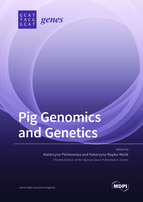Generation of Marker-Free pbd-2 Knock-in Pigs Using the CRISPR/Cas9 and Cre/loxP Systems
Round 1
Reviewer 1 Report
The authors demonstrated the possibility of developing a model to study the anti-infection mechanism or to develop a disease resistant pig by inserting the pbd-2 gene into a safe harbor locus. The method of inserting pbd-2 gene or analyzing off-target using CRISPR is well-designed, and experimental results consistently support the authors' claims. I have only minor suggestions to revise this study.
Minor
- In method section, the description of Southern blot analysis is missing.
- In Page3, line 108-109: please add a reference to the PK-15 cell.
- in Figure 2B, please show how authors designed a primer to test whether it is bi-allele or mono-allele insertion in the knock-in process of PBD-2.
- in Figure 2C, Southern blot image is not so clear, so it would be nice to add the sanger sequencing result of the knock-in part.
- in Page9, line270. Typos: predicted off-target sites
Author Response
Please see the attachment.
Author Response File: ![]() Author Response.docx
Author Response.docx
Reviewer 2 Report
The authors generated marker free pbd-2 transgenic pigs using CRIPSR/Cas9. Overall the reviewer found the study well-designed but have 3 comments that they will like the authors to consider.
1) While the reviewer acknowledges that Cas-OFFFinder is used for off-target predictions generally, any efforts towards commercializing transgenic pigs (which seems to be the ultimate goal of the work) should involve deep-sequencing of all transgenics produced. Cas-OFFFinder and any other software developed for such predictions may not be fully exhaustive. While this may be out of scope of this study, the reviewer believes that the possibility that the off-target analysis was not be exhaustive and future efforts would need to address that, should be discussed briefly.
2) The reviewer has some queries on Figure 4 and associated data.
a) Minor comment- Please consider changing the labels in the Figure. The authors talk about the panel C first and then panel B and this affects readability.
b) The authors should mention how many of the TG and WT samples were replicated to the representative data that is being presented.
c) Figure 4A- how much total RNA was put in the RT-PCR? The reviewer could not find this but this is important information.
d) Figure 4C- There are some crucial things that need to be considered here- please ensure that the number of cells in the WT and TG are same or similar. The cells in the WT sample are significantly less that the TG. While this may or may not change the results, ensuring similar number of cells at least makes the data semi-quantitative and more impactful.
e) On a similar vein, please mention the microscope settings in which the images were taken (which would be the same setting in both WT and TG samples). time of exposure, lens magnification used etc. As the authors are aware, changing settings across images, samples and controls can change or modify output.
Author Response
Please see the attachment.
Author Response File: ![]() Author Response.docx
Author Response.docx





